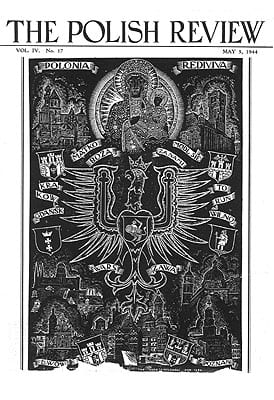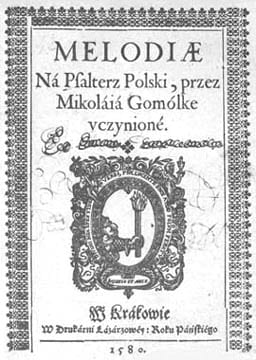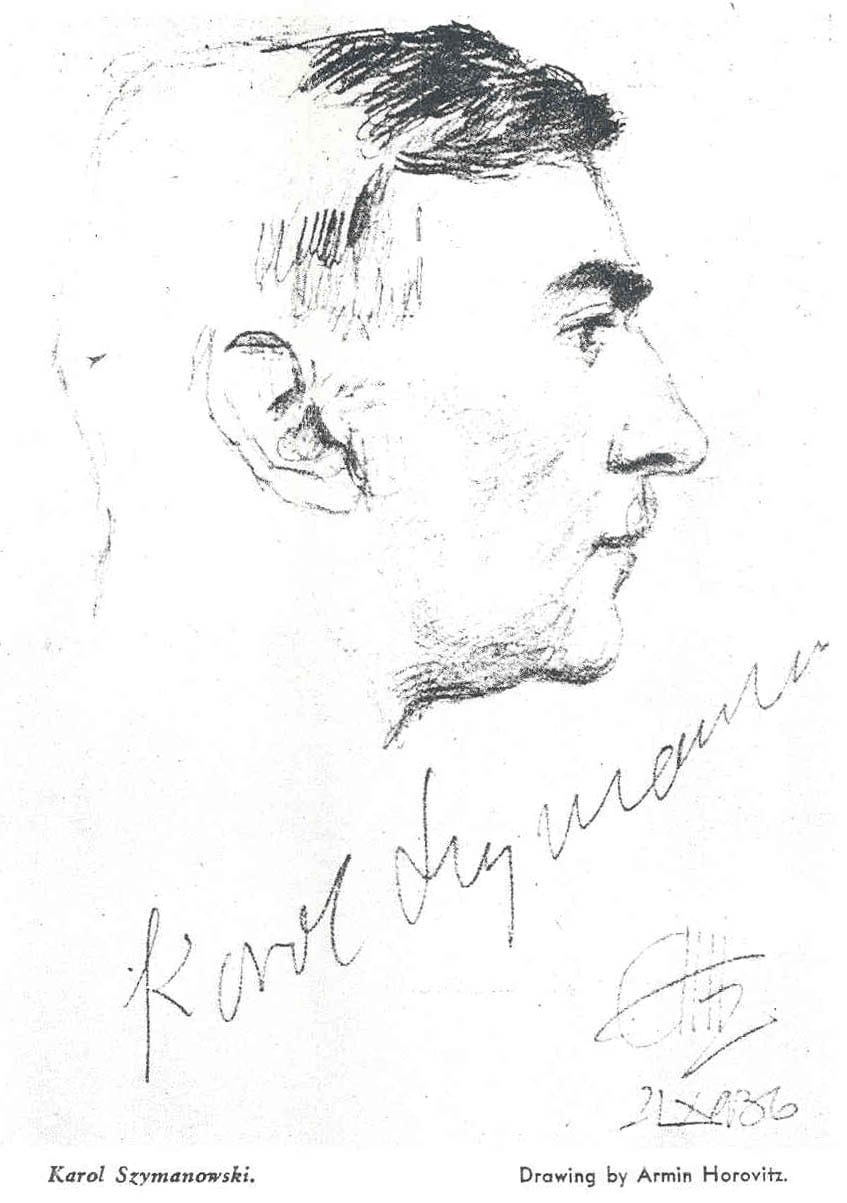by Feliks R. Łabuński [1]
The Germans well know that music and song form of Polish Culture. So, in their mad attempt to stamp out the Polish resistance, the savage Huns are brutally destroying every outward and visible sign in this field dear to the hearts of Poles. Chopin’s statue in Warsaw–symbol of Polish national music–was the first victim of their vandalism.—From the Polish underground Press.

The development of Polish music was closely connected with the history of Poland. Music flourished during the periods of its independence and prosperity, and declined in the years of partition and depression. The first foundations of Polish music were laid by the rites of the Roman Catholic Church. The medieval era produced various anthems and songs of unknown authorship. In 1364, the foundation of Cracow University gave impetus to national art and culture. The earliest known Polish composer, Nicolas of Random, who appeared at the end of the 14th century, composed homophonic hymns and anthems, in Florentine style, as was the fashion of the day. [2]By the beginning of the 16th century, the Renaissance movement had reached Poland. In 1543, King Zygmunt Jagiellon founded in Cracow the Rorantists Capella, destined to play a very important role in the growth of music. [3]This period produced composers of great merit, among whom the most interesting were Szamotulski and Gomółka. [4]

Gomółka was one of the first composers to use popular songs and anthems in his melodical material. He ranked among the most-daring innovators, and was the first European composer to introduce into musical fabric the chord of the dominant seventh, and he even used the chord of ninth.
The Baroque movement started in Poland, and dates from the Waza dynasty, lavish patrons of the arts, especially music. Warsaw became the center of musical development, which reached its peak in the 17th century. Mikołaj Zieleński was the most prominent musician of this period and one of the greatest of Polish composers. [5]In 1611, during his lifetime, his 119 vocal and instrumental works were published in Venice and his name became widely known in Italy and throughout Europe. Instrumental music was the domain of two gifted composers Jarzębski and Mielczewski, who did much for the development of chamber music in Poland. [6]Jarzębski’s music was in advance of the times: he used the chromatic style then to be found only in the works of Frescobaldi.
The first half of the 18th century was characterized in Poland by the growth of secular music, the further development of instrumental music and the shifting of art patronage from the court to the wealthy magnates and landlords. Never had there been so many private Capellas and orchestras. Rich landlords had their own theatres with opera, soloists, chorus, ballet and orchestra. Families like the Ogiński and Radziwiłł were not only patrons of music, but produced amateur composers, conductors and instrumentalists. Two outstanding composers, Gorczycki and Szarzyński shed luster on this period. [7]The former devoted himself to vocal religious music, the latter to instrumental music. When Poland began to decline as a state in the middle of the 18th century, a decline of culture and the arts also set in. The third and final partition of Poland in 1795 checked for some time the development of music. But three hundred years of fruitful growth had laid a solid foundation for the future and prepared the way for Frederick Chopin, greatest of Poland’s composers.

The talent of Chopin grew in Warsaw during a short breach in the dark period of Poland’s history. By a decision of the Congress of Vienna in 1815, a part of Poland, which was under Russian occupation, became the Congress Kingdom, the comparatively liberal constitution of which affected favorably the musical life in Warsaw. Joseph Elsner, a prominent composer and teacher, had founded the National Conservatory of Music, and had as his pupil Chopin. [8]This period of comparative freedom lasted only 15 years, till the tragic insurrection of 1831, but this lapse of time was luckily sufficient to enable Chopin to finish his musical education and achieve maturity in his own country, under his beloved teacher.
Although Chopin spent the last eighteen years of his life abroad, chiefly in France, his music never for a moment lost its essentially Polish character. It exercised a great influence on European and Polish music; it incited and strengthened the spirit of freedom and independence in his fellow countrymen living under a foreign yoke. Paderewski called Chopin “that clever smuggler who manages in the pages of his music to cross the borders of an outlawed Poland.” These words have not lost their meaning. Today Chopin’s music is forbidden in German occupied Poland. Nothing better describes ‘s what Chopin’s music means to Poles than the words of Karol Szymanowski: [9]
To us Polish musicians, Chopin is a real and everlasting force, a power that exercises a direct and spontaneous influence on the evolution of Polish music. In all our musical past, it is the work of Chopin that is of incontestable Polish style, in the deepest and noblest meaning of the word. To us Chopin is the symbol of what is genuinely great in Polish music, yet more than that, he is our Master who by his wonderful art solved the essential problem of every great artist—how to attain in one’s own work the perfect expression of profound and universal human dignity, without the sacrifice of individual traits or national originality.
Chopin’s music was the genesis of a new and very fruitful national movement that despite political oppression, which sought to exterminate Polish patriotism, developed with great vigor. A typical representative of this movement, thoroughly romantic in spirit, was Stanisław Moniuszko (1819-1872). He was the first composer to develop the Polish art-song, originated by Chopin, and left more than three hundred of them, more than any other Polish composer. He was also the first to compose a distinctly Polish opera, different from anything previously written. “Halka” and “Straszny Dwór” [The Haunted Manor] are the best known of his nine operas.

During the last quarter of the 19th century and the beginning of the 20th century, the political situation in Poland became less strained. Musical life continued to progress steadily, up to the outbreak of the last war. This period was marked by the development of symphonic music and produced several distinguished composers: Władysław Żeleński (1839-1920) chiefly known as the author of the opera “Goplana,” and of symphonic and chamber music. Zygmunt Noskowski’s (1840-1909) most representative works are two symphonic poems “Step” and “Morskie Oko.” Juljusz Zarembski (1854-1885), pupil of Liszt, devoted himself chiefly to piano and chamber music and wrote an excellent piano quintet. [10] Ignace Jan Paderewski (1860-1941) is primarily known as a composer for the piano, but his rich legacy includes opera “Manru,” a Symphony, a Concerto and “Polish Fantasy” for piano and orchestra, also a few songs, all of genuine Polish character and expert craftsmanship.

The period which preceded the outbreak of the last war saw the rise of a new generation of composers who continued their creative work after the rebirth of Poland. Zygmunt Stojowski (b. 1870) who made his permanent home here some thirty-five years ago, is known for various orchestral works, especially his Symphony in D Minor, also for his popular piano pieces. While romantic, his music reveals classical tendencies. Four composers of this period, Karłowicz, Fitelberg, Różycki and Szymanowski, all pupils of Noskowski, founded a group known as Młoda Polska, or Young Poland, which had a very important influence on the evolution of Polish music. [11] They wrote in the form of the symphonic poem, at that time in great vogue, and as subjects chose abstract symbolic ideas, or Polish historical ballads and poems. To the former belong “Returning Waves” and “Eternal Songs,” by Karłowicz, to the latter “Warszawianka” by Różycki, and “Polish Rhapsody” by Grzegorz Fittelberg. The only one of this group who disregarded the symphonic poem and wrote symphonies was Szymanowski. He composed three of them and a concert overture.
The rebirth of Poland in 1918 saw a great creative movement in music. The new enthusiasm of a freed country found expression in a general renaissance of art, especially marked in music. This movement affected Karol Szymanowski (1883-1937), one of Poland’s greatest composers, whose music was already known and appreciated in Europe. Szymanowski found his own style by contact with his reborn country and al1 its folklore. He wrote the “Stabat Mater,” Symphony Concertante, Second Violin Concerto and the ballet “Harnasie.” Although he leaned more toward classicism, as he grew older, he was the last representative of the great romantic trend that had dominated Polish music since Chopin. A reaction against this trend and a revival of classicism came around 1930, from the first generation of composers of independent Poland. While elsewhere in Europe neo-classicism produced music almost totally devoid of emotion, that at times partook not only of the spirit of classical composers, but of their style and melodic material, emotion still played an important role in Polish music of this generation. Ever since the early 14th century it had been a distinguishing trait of Polish music. Instead of borrowing melodic material from the old masters, Polish composers turned to their native folklore, where they found a rich and unexplored field of inspiration.
Several of these young composers, after being graduated from music schools and conservatories in Poland, went to Paris, at that time the world’s center of music. In 1927, Perkowski, Wiechowicz, the writer, and a few others founded the Association of Young Polish Musicians, a center for all Polish musicians who went to France, which during the following 12 years played its part in developing a new generation of composers and performers. To this generation belongs also Michał Kondracki, Jan Maklakiewicz, Roman Palester, Kazimierz Sikorski, Antoni Szałowski and Bolesław Woytowicz. [12] Their music is remarkable for its model character and unusual scales, derived from Polish folk music; by its fresh and vigorous rhythm; by its humor and healthy objectivism, all in keeping with the spirit of the new Poland, a spirit of action, optimism and self-reliance. To these men whose education, or creative activity during 1918-1939 was carried on in Poland, we must add a few who spent these years abroad, but nevertheless belong to Polish music: Alexander Tansman, Tadeusz Jarecki, Czesław Marek, Jerzy Fitelberg and Karol Rathaus. [13] Tansman, though educated in Poland, established himself in Paris, about 1920. He is one of the most prolific of present-day composers, and has to his credit more than seventy opuses, among which the best known in this country is the “Triptyque” for string orchestra. Jarecki began his musical education in Poland but completed it abroad. He established himself after the last war in New York, and his Second String Quartet won the Coolidge Prize in 1918 and was successfully performed here. Czesław Marek settled in Switzerland where he has lived since 1916. His worldwide reputation dates from his winning the Second Prize for a symphony at the Schubert Memorial Contest. The musical education of Jerzy Fitelberg and Karol Rathaus took place in Germany. Both lived there until about 1933, and later established themselves respectively in France and England, coming to the United States at the outbreak of the war. Fittelberg’s medium is mostly orchestral and chamber music, and his Fourth String Quartet was awarded the Coolidge Prize in 1936. Rathaus’ work is extremely varied, including incidental music for the theatre and the movies. His orchestral overture “Uriel Acosta” is one of his most frequently performed works in this country.
Notes
[1]. This and all subsequent notes by Maja Trochimczyk. Article published in The Polish Review 4, no. 17 (May 3, 1944). This periodical was associated with Zygmunt Stojowski (who was one of its editors) and the copy used here comes from the Zygmunt and Louisa Stojowski Collection, now at PMC. Feliks Roderyk Łabuński (1892-1979) and his brother Wiktor were musicians (Wiktor was a pianist and wrote about his meeting with Paderewski, PMJ 4 no. 1.2001), who immigrated to the U.S.; Feliks in 1936 (a citizen since 1941). He studied with Witold Maliszewski in Warsaw, Paul Dukas and Nadia Boulanger in Paris. While in Paris he was a co-founder of the Association of Young Polish Composers in Paris; since 1945 professor at Cincinnati College Conservatory of Music. See James Wierzbicki, “Traditional Values in a Century of Flux: The Music of Feliks Labunski (1892-1979),” PMJ 4, no. 1 (2001). [Back]
[2]. Mikołaj Radomski (Nicolaus de Radom), Polish composer active in the first half of the 15th century; composed religious music similar in style to works by Cicconia, Dufay, i.e. late French and Italian Ars Nova. [Back]
[3]. Zygumunt I “Stary” (Sigismond I “The Elder”) ruled Poland in 1506-1548. [Back]
[4]. Mikołaj Gomółka (ca. 1535-1591) was a Calvinist composer of religious polyphony in Polish, including the famous Psalter translation by Jan Kochanowski. See Mirosław Perz, Melodie na psałterz polski Mikołaja Gomółki: Interpretacje i komentarze [Melodies to a Polish Psalter by M.G.: Interpretations and commentaries] (Kraków: Polskie Wydawnictwo Muzyczne, 1988). Wacław z Szamotuł (ca. 1520-1560), composer of vocal polyphony active at the royal court in Kraków. See Katarzyna Grochowska, “Wacław of Szamotuły, the jewel of the Polish Renaissance: Indigenous or imported?” European Meetings in Ethnomusicology 9 (2002): 179-186.[Back]
[5]. There is no extant biographical information about Mikołaj Zieleński (early 17th c.). His Offertoria/Communiones totius anni of 1611 includes over 50 compositions, mostly in monumental polychoral style, with a 12-part Magnificat for three choirs. See Włodzimierz Malinowski, Polifonia Mikolaja Zieleńskiego (Warsaw, 1974). [Back]
[6]. Adam Jarzębski (d. 1648 or 1649), Polish composer, violinist and writer, influenced by Italian Baroque music, composer of instrumental canzonas, including works based on Italian vocal music, preserved in Canzoni e concerti (1627), published in the series Monumenta Musicae in Polonia (1989). Marcin Mielczewski (d. 1651), studied with Franciszek Lilius, was active at the royal chapel in Warsaw and composed a large number of works in various genres, predominated by the “concertato” principle. His music was published in Marcin Mielczewski, Opera omnia, ed. Z.M. Szweykowski, Monumenta Musicae in Polonia (1976) and his life was studied by Zygmunt M. Szweykowski, Marcin Mielczewski: Studia (Kraków: Musica Iagellonica, 1999). [Back]
[7]. Grzegorz Gerwazy Gorczycki (c. 1665 – 1734). Polish composer educated as a priest (studied philosophy at Prague and theology at Vienna). Active in Kraków, he mostly composed liturgical music to Latin texts in both older and newer concertato styles. See Grzegorz Gerwazy Gorczycki, Opera omnia, ed. Karol Mrowiec, Monumenta Musicae in Polonia (1995) and Agnieszka Wardecka-Gościńska,Katalog tematyczny [Thematic catalogue]. Stanisław Sylwester Szarzynski (17th c.), Polish composer with scant biographical information; and extant copies of works are dated 1692 to 1713. Wrote sacred vocal music in concertato style, often using popular religious melodies as subjects. [Back]
[8]. Józef Elsner (1769-1854). See Alina Nowak-Romanowicz, Józef Elsner (Kraków: PWM, 1957); Anne Schwarz, “Elsner, Chopin, and Musical Narrative as Symbols of Nation,” Polish Review 39 (1994): 445-56. [Back]
[9]. A paraphrase from the conclusion of Karol Szymanowski’s first essay on Fryderyk Chopin, written in 1922-23, published in 1923, reprinted in Karol Szymanowski, Pisma muzyczne[Writings about music], ed. Kornel Michałowski (Kraków: PWM, 1984), 89-103. English translation by Maria Piłatowicz, in Maja Trochimczyk, ed., After Chopin: Essays in Polish Music(Los Angeles: PMC, 2000), 47-62. The citation’s original appears on p. 61-62 in the translation. [Back]
[10]. Juliusz Zarębski (1854-1885), pianist and composer who studied in Vienna and St. Petersburg, as well as with Liszt (1875). Taught at the Brussels Conservatory and composed piano, and chamber compositions and songs. [Back]
[11]. Mieczysław Karłowicz (1876-1909), see Alistair Wightman, Karłowicz, Young Poland and the Musical fin-de-siècle (Aldershot: Ashgate, 1996). Ludomir Różycki (1884-1953). See Stefania Łobaczewska, “Ludomir Rózycki (1884-1953),” in Z dziejów polskiej kultury muzycznej [From the history of Polish musical culture] (Kraków: PWM, 1966), 579–604. Grzegorz Fitelberg (1879-1953), conductor and composer, father of Jerzy. See Leon Markiewicz, Grzegorz Fitelberg 1879-1953: Życie i dzieło [His life and works] (Katowice, 1995). Karol Szymanowski (1882-1937). [Back]
[12]. Michał Kondracki (1902-1984). Jan Maklakiewicz (1899-1954). Roman Palester (1907-1989), see Zofia Helman, Roman Palester (Kraków: Musica Iagellonica, 2002). Antoni Szałowski (1907-1973), one of Poland’s leading neo-classical composers. Bolesław Woytowicz (1899-1980) studied piano with Michałowski and composition with Szopski, Maliszewski, and Boulanger. His music evolved from neoclassicism to dodecaphony. [Back]
[13]. Alexander Tansman (1897-1986) is listed in the New Grove Dictionary as a French composer and pianist of Polish birth. See Jill Timmons & Sylvain Fremaux, “Alexandre Tansman. Diary of a 20th-Century Composer,” PMJ 1, no. 1 (1998). Tadeusz Jarecki (1889-1955), Polish-American composer and conductor, lecturing at Columbia University. Czesław Marek (1891-1985) emigrated to Switzerland. He studied with Niewiadomski, Leschetizky (piano), Adler (musicology), and Pfitzner (composition), following a late romantic stylistic orientation. See Kurt von Fischer, Czesław Marek (1891-1985) (Zürich, 1987). Jerzy Fitelberg (1903-1951), composer educated in Berlin and Paris (with Schreker), settled in the U.S., composed music for orchestra, chamber ensembles and soloists, in neoclassical style. Karol Rathaus (1895-1954), American composer and pianist of Polish origin; studied composition with Schreker, lived in Vienna, Berlin, Paris, and taught at CUNY, New York. See Boris Schwarz, “Karol Rathaus,” Musical Quarterly 41 (1955): 481-92; Don Pirone, The Solo Piano Music of Karol Rathaus: A Performance Guide (D.M.A., New York University, 1984). [Back]